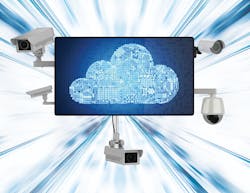This article originally appeared in the September 2022 issue of Security Business magazine. When sharing, don’t forget to mention Security Business magazine on LinkedIn and @SecBusinessMag on Twitter.
Each year, demand for video surveillance continues to grow, offering integrators many new opportunities for projects. While standalone hardware installation projects are profitable, savvy integrators aim to build services into their offerings to ensure a continued stream of revenue after installation is completed.
As more end-users become comfortable with cloud-based technology for their IT and business systems, opportunities are available for security integrators to sell cloud-based services related to video surveillance and build their recurring monthly revenue (RMR). These services range from health monitoring for cameras, to alarm management, up to a full video surveillance as a service (VSaaS) offering complete with cloud storage.
Cloud-Based Device Management
By connecting cameras to the cloud, integrators can provide a chargeable service to end-users for monitoring connectivity and the health of devices. Technicians can proactively monitor the status of an end-user’s devices as it relates to connectivity, recording status, or availability of new firmware.
They can change configuration settings, calibrate cameras for video analytics purposes, and perform maintenance tasks supported by the cloud remotely without the need to visit the customer site. Tasks can even include firmware updates to ensure that a system continually meets the highest performance and security standards.
Video Surveillance as a Service (VSaaS)
VSaaS enables end-users to monitor video, manage events, record and replay video security footage from anywhere via the cloud. With a full VSaaS implementation, cameras are the only hardware investment needed on-site, which benefits many businesses with space constraints or those that desire little to no equipment on premise.
End-users can easily and securely access and manage their live views and recordings – and even perform forensic searches – anytime and anywhere from any smartphone, tablet, or computer for flexibility and operational efficiency.
VSaaS is also cost-effective for the end-user. They only pay for the services they use. No servers are required to install, update or maintain, so businesses can quickly realize the cost-effectiveness of their investment by decreasing site visits for storage equipment and server upkeep. They can add cameras where and when they need them and all software maintenance, configuration settings, and related processes are handled remotely by the integrator. Easy to scale, VSaaS services can support thousands of cameras.
The concept enables your customers to adapt a security solution that meets their budgets and needs. It reduces their upfront investment and may also provide greater financial flexibility with ability to tap into both a capital budget (for the cameras) as well as an operational budget (for the service).
With VSaaS, integrators gain recurring service revenue and benefit from fewer customer visits for maintenance and support. In addition, extending storage capabilities is easier if the user needs additional cloud storage based on changing requirements or retention time needs.
Increase Revenue via Alarm Management
By adding alarm management, integrators gain increased revenue for configuring and managing alarms and monitoring and reacting to events at customer sites. VSaaS supports the ability for a monitoring center to investigate potential situations based on a full event overview with live streams and an interactive map. It enables intervention capabilities, such as audio communication to prevent possible site damage for events in progress or help from a virtual assistant when an emergency button is pushed. It also aids in capturing evidence for law enforcement, as video clips of events can be stored in the cloud. Dealers and integrators may also add incremental revenue by offering alarm push notifications to mobile devices to improve the end-users’ awareness of events at their facilities.
Alternatively, instead of monitoring video footage 24/7, intelligent VSaaS offerings can alert when needed with artificial intelligence (AI) at the edge and in the cloud. Cameras with built-in video analytics autonomously detect pre-defined situations and trigger the cloud-based alarm management service. If needed, the cloud service will alert users to take appropriate action. When implementing intelligent solutions, it is important that the video analytics is robust enough to minimize false alarms by differentiating between real security events and false triggers – such as snow, wind (moving trees), rain, hail, and water reflections – that can make video data more difficult to interpret.
Nevertheless, an actual alarm can still be unwanted based on customer requirements, which can result in high costs because a response is needed. With additional enhancements to VSaaS, an AI-based alarm verification service can help filter unwanted alerts to only detect true events. For example, an animal detected by the camera alongside a perimeter is a valid alert, but unimportant for perimeter security.
An AI-based alarm verification service will filter such unwanted alerts. The advantages of such a service are minimizing false alarms, reducing costs, and strengthening the reliability of the security application. It makes it possible to tailor alerts to a customer’s needs, filtering unwanted alarms, increasing efficiency, and minimizing costs.
Target Applications and Verticals
While various types of organizations can benefit from a full VSaaS implementation, here are three specific scenarios that are an ideal fit:
Logistics centers are prone to vandalism and theft, mainly due to their remote locations. Additionally, it is not always cost-effective to have security guards monitor the sites outside of business hours. VSaaS offers an ideal solution here, since it offers 24/7 monitoring from anywhere. When an event occurs, the system can alert the user to take appropriate actions. Adding prerecorded or live audio can reduce after-hours break-ins and discourage property damage.
Businesses with multiple sites across a city, region, or country, such as retail or gas station chains, will benefit from the simplified operations and reduced equipment maintenance needs with VSaaS. For these organizations, managing hardware across tens or hundreds of locations can be challenging and costly. VSaaS offers a more reliable, efficient, and cost-effective solution by reducing the amount of hardware at each location.
Temporary installations, such as construction sites or event venues, are often easy theft and vandalism targets. Having personnel on-site is not always practical. VSaaS enables a more effective way to secure the perimeter, protecting equipment and property, with no additional hardware required on-site other than the camera(s). Video analytics can alert a user, helping them act on what they see or trigger prerecorded audio to ward off intruders.
Additional target applications include energy production sites with distributed or remote sites, financial institutions with multiple locations, and educational facilities that have a need for classroom monitoring capabilities.
Hybrid Approach
Even if end-users prefer not to implement a full VSaaS solution, integrators still have an opportunity to sell video services with hybrid installations – specifically with cloud storage.
The decision to implement cloud-managed video vs. traditional on-premise technology depends on the needs of the organization, and end-users may choose a hybrid approach for a variety of reasons. For example, they may want to continuously record on-premise while having event-driven recordings sent to the cloud. They may also choose this type of approach if they do not have the necessary upload bandwidth required to stream large amounts of video to the cloud.
The end-user’s need determines what architecture would be the best fit and if there are opportunities to sell services using a hybrid approach.
Choosing a Service Provider
When choosing a VSaaS provider partner, there are many factors to consider, including flexibility, integration capabilities, data security, and the ability of the offering to be enhanced as technology advances.
Innovations in AI are happening quickly. Ensure the VSaaS offering is future-proof and able to keep pace through firmware updates and the ability to add new service offerings as video systems become more intelligent. The ability to adapt will further minimize unwanted alarms and deliver insights enabling solutions that are tailored to specific customer needs.
The service should also be flexible to work with cameras from multiple manufacturers when needed. This will enable integrators to meet end-user budgets without proprietary camera lock-in. Integration with a range of alarm automation platforms, including workflow integration, will also provide integrators the freedom to work with their preferred monitoring centers.
In addition, multiple options for storage size are important for flexibility, and high storage reliability should ensure data is securely backed-up with a resilient distribution concept. In addition, proper measures need to be in place to maximize data security, including certificate based end-to-end security and regular and automated system updates.
By understanding the customer’s need and IT requirements, integrators can recommend a system architecture that would be the best fit for the organization. With possibilities for cloud-based services that range from remote device management and health monitoring for cameras to a full VSaaS offering, there are many opportunities for security dealers and integrators to build RMR into video surveillance projects to cultivate additional business growth.





